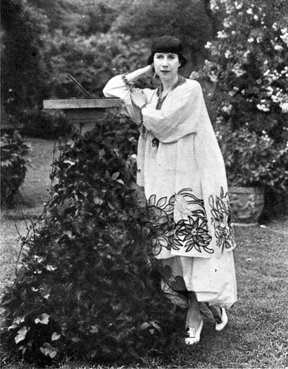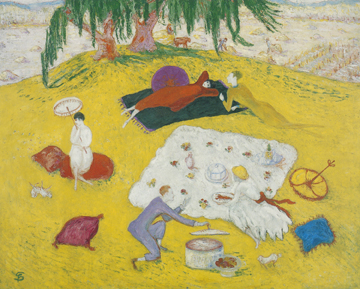Art Essay: Florine Stettheimer and Picnic at Bedford Hills:
Subverting the Separate Spheres
By Rena Tobey ©2015
ART TIMES Fall 2015
 Florine Stettheimer, c.1917-1920. Image held in the collection of the Florine Stettheimer papers, Rare Book and Manuscript Library, Columbia University. |
With the end of World War I, a new type of New Woman was emerging: The Flapper. Born of post-war prosperity, the Flapper was willful, self-pleasing, strong, politically aware, socially savvy. Just on the cusp of ratifying the 19th Amendment in 1920, granting the right for American women to vote, the Flapper was the youthful expression of that radical thinking. The Flapper rebelled against the restraints of old-fashioned Victorian womanhood. The war had also opened up male occupations to women, and they were reluctant to release those positions and the new freedoms and confidence associated with success in the public sphere. The media responded with visual backlashes against working women and Flappers, with satirical cartoons and illustrations, as well as editorial reassurance that the home and family would still be central to American society. With a barrage of media images, the Flapper evolved to a party-girl image, focused on leisure and consumption, offering no real threat to the status quo.
Florine Stettheimer (1871-1944) represented the kind of New Woman who could also be labeled a Flapper. Unlike so many immigrants, Stettheimer’s Jewish family was assimilated and wealthy. But not until her father deserted the family and older siblings moved away, did the remaining sisters and their mother form a powerful bond. They traveled extensively in Europe in the early 1900s. Stettheimer and her sisters were exposed to intellectual circles and bohemian values. Neither she nor her younger sisters married, and each was attracted to the arts. Ettie became a writer, while Stettheimer studied painting and was influenced by Robert Henri (1865-1929), the leader of the Urban Realist movement initially focused on depicting the grit and grime of New York City life.
When the Stettheimer family returned permanently to New York in 1914, Stettheimer, her two sisters, and their mother established a conversational salon in their large apartment. The salon became a gathering place of intellectuals, writers, and avant-garde artists such as Stettheimer’s close friend Marcel Duchamp (1887-1968), to discuss the arts, politics, and social reform. For salon gatherings, the sisters played with their appearance and identity, wearing wigs, vintage clothing, and costumes. They smoked cigarettes and dismissed conventional values and roles for women, wearing pants as a symbol.
In general, salons became a vehicle for female emancipation and sexual mobility, and the Stettheimer New-Woman-style salon created an in-crowd of women and men with both feminist and feminine energy. Duchamp famously experimented with embodying both genders and referred to Stettheimer as a ‘bachelor’, a pun on her marital status, as well as conferring on her a bachelor of arts. The Stettheimer women were independent, unapologetic about their unmarried status, and reminded many of the 19th-century aristocratic, yet radical feminists of the Woman’s Movement.
 Florine Stettheimer, Picnic at Bedford Hills, 1918, Pennsylvania Academy of the Fine Arts |
Following negative reviews of her 1916 solo show, Stettheimer mostly exhibited her paintings in small private exhibits or in her studio, and with the protection of her wealth, refused to sell her work. This choice meant her art was easily neglected, which she resented, wanting to blend the impossible—the desire for recognition without the willingness to receive criticism. Her well-known demand that any gallery wishing to show her work would need to be redecorated like her home suggests not only her independent mind, but also her willingness to be both indelicate and flippant toward the art market.
Stettheimer’s unusual demand also implies a tension between the public sphere of commerce and politics and the private, domestic domain, but in reverse from the Gilded Age, which came to a close with the World War. If the art market of the commercial sphere wanted her work, then it must come to her private domain. She would not meet at the boundary between the spheres. She would not compromise. She effectively split the art world she actively participated in from the art market. While creating a kind of art mythology and stubborn independence of standards, she also risked not being taken seriously.
The boldness of her rejection of the commercial world freed her art to become more eccentric. Many of her subjects quirkily reflect both public and private concerns. She recorded events like an observer, neutral and removed. Instead of depicting the gritty realities of New York streets of the Urban Realists, Stettheimer’s world displayed candy-colored parties, vacations, dinners, and gatherings of well-known, avant-garde intellectuals.
Yet her witty paintings are deeply personal, almost diary-like, fanciful, and dreamy. While her later work is satirically full of social commentary about modern life, described by one critic as like a comic opera, an early work like the Picnic at Bedford Hills from 1918 shows how Stettheimer melds the public and private spheres, from the vantage point of neutral observer and an intellectual insider.
The painting’s seemingly simple depiction of a picnic on a pleasant day painted in Stettheimer’s characteristic decorative, expressionistic style also suggests a world in radical transition. The viewer is placed at a distance from the action, to more easily take in and consider the whole scene. Not only is the viewer removed, but also placed high above the action of the scene, as if hovering from the top branches of an unseen tree. As characterized by the upside-down parasol, this world is unconventional, from the yellow hillside and purple-trunked trees to the boneless, androgynous, doll-like figures. Stettheimer paints a sprite-like Duchamp in yellow next to her reclining self-portrait in red. Also at the picnic are her sister Ettie, who appears in several Stettheimer paintings, and artist-friend Elie Nadelman (1882-1946). The sculptor Nadelman has been credited with introducing Stettheimer to a simpler ‘folk’ style that suggests rather than portrays specificity.
The scene also contains the artist’s commentary. Not only does Stettheimer record herself and friends at leisure, but also the working farm world, which the principal characters blithely ignore. In the background, at the top of the hill, the viewer can just make out an oxen-pulled, yellow cart and hint of plowed fields beyond. A wry comment about excess also sits in the center of the foreground. As two figures prepare the picnic spread, one lifts the lid from an enormous pot of food, perhaps made from the raw ingredients being produced in the background. The viewer has the vantage point of looking down on the scene, creating a journalistic assessment. Stettheimer seems to comment, this is what the world is like: the relaxed oblivion of the wealthy, who have the privilege to challenge convention with modern lifestyles—the latest bobbed hair and shortened hemlines, sexual freedom, and excess consumption—all commanding attention, even as the worker’s world ensures maintenance of the class status quo.
The figure to the left, who sits on her own, face turned away from the scene, disconnects herself from the rest. She seems bored by, disinterested in, or perhaps critical of the wealthy, leisure class. However the viewer interprets her thoughts, the figure seems to be at a loss for how to make meaningful connection. She appears to embody the ambivalence and disconnection of the post-war malaise that infiltrated American and European culture.
Perhaps, with this disengaged figure, Stettheimer is also prophetic about what women would experience after the enactment of suffrage in 1920. While the issue of the vote unified various strands of politically active women, in the 1920s, disparate agendas would re-diversify and splinter their energy. While the National Woman’s Party slowly reorganized around a new push for an Equal Rights Amendment, numerous other organizations emerged with reform agendas for protecting women in the workplace, child labor, women serving on juries, health insurance, unemployment compensation, hours and wages legislation, education, and other social welfare issues. Organized feminism lost momentum until the New Deal, as various groups attempted with only modest success to enact their priorities.
Another agenda centered on New Woman ideology contained in Stettheimer’s intellectual salon. The Stettheimer salon, along with other women-dominated gatherings, not only allowed identity and sexual experimentation, but also served as a kind of buffer from a world still segregated based on religion. The New Woman was evolving, changing with legislation, economic realities, and loosening mores. Stettheimer subverted the traditional Separate Sphere ideology by demanding that the public sphere come to her, in her domestic domain. She made the private public and challenged the public to become private. Buoyed by her affluent epoch, Stettheimer teased the art world with her personal depictions that only barely covered social commentary. She would go on to dissect New York’s social and economic worlds in her Cathedral Series, four paintings she made between 1929 and 1942, when the world, and women’s roles in it, would crumble and have to be rebuilt yet again.
This essay is the 6th from the "Finding Her Way" series, exploring the challenges American women artists faced from about 1850 to 1950.
Previous essays:
Elizabeth Okie Paxton Summer 2014
Lilly Martin Spencer Fall 2014
Alice Barber Stephens Winter 2014
Marie Danford Page Spring 2015
Theresa Bernstein Summer 2015
